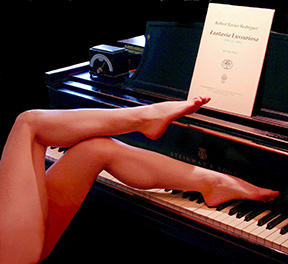Fantasia Lussuriosa
for piano solo
Duration: 12 minutes
Commissioned by Hélène Wickett
Premiere Performance: October 18, 1989; Hélène Wickett;
The
University of Texas at Dallas
Photo: Ellen Locy, Model: Mary-Margaret Pyeat t
t
Reviews:
…based on passages from two other Rodríguez compositions: the “Lust” theme from his ballet The Seven Deadly Sins (1985) and the “Sensual indulgence is a sure road to sin and damnation” melody from his comic opera Suor Isabella (1989)… reveals a unique and unexpected mixture of diverse elements: avant-garde melodies, counterpoint, and transient tonalities coexist with more traditional jazz-inspired harmonies…an exciting tour-de-force …powerful and shocking…a provocative and fascinating work…
Ernest Kramer, Clavier Companion
…particularly compelling, with its seductive lines, decadent melodic embroidery, and all-encompassing virtuosity…
Rorianne Schrade, New York Concert Review
The afternoon's biggest treat was Fantasia Lussuriosa… True to the title, which suggests fantasy and lust, the seductive yet playful set of variations ran the gamut from a frenzied Viennese Waltz to sultry slow blues… steamy passion… an exquisite hint of lingering ardor.
Ken Iisaka, Classical Sonoma
Fantasia Lussuriosa is a surprising set of variations for piano. Its jazzy character is highly appealing. It's virtuosic enough to serve as a test piece at the Cliburn Competition.
Olin Chism, The Dallas Morning News
Composer Note:
Fantasia Lussuriosa (1989), literally “Lust Fantasy,” is a ten-minute set of virtuoso variations for solo piano on the “Lust” theme from my ballet The Seven Deadly Sins (1985). As an ironic counterpoint to the Lust theme, I include a quotation from my 1981 comic opera Suor Isabella, set to a line from Daniel Dibbern’s libretto: “Sensual indulgence is a sure road to sin and damnation!” The work was commissioned by Hélène Wickett, who gave the premiere performance at The University of Texas at Dallas in 1989. I subsequently revised the piece in 1996, and Jeff Lankov gave the first performance of the revised version that same year, also at UT Dallas. In 2011, Lankov produced the present newly-edited version of the score.
The music combines elements of blues and jazz with a fusion of 19th and 20th-Century virtuoso piano techniques. Complex rhythms abound, often layered in multiple lines of counterpoint, with voices crossing rapidly back and forth between the hands. Of particular inspiration in the piano writing was Schumann’s brilliant Symphonic Etudes.
In its original orchestration in The Seven Deadly Sins ballet, the Lust theme features two intertwining pairs of saxophones, accompanied by, at one point, a whip. I have quoted the theme in three other works to invoke lustful associations: in the orchestral overture Piñata (1991) and in both of my full-length operas: The Old Majestic (1988) and Frida(1991). The harmonic changes of the theme also appear in the piano accompaniment to my Six Maxims de la Rochefoucauld (1991) under the vocal setting of the text, “Jealousy is born with love, but it does not always die with love.”